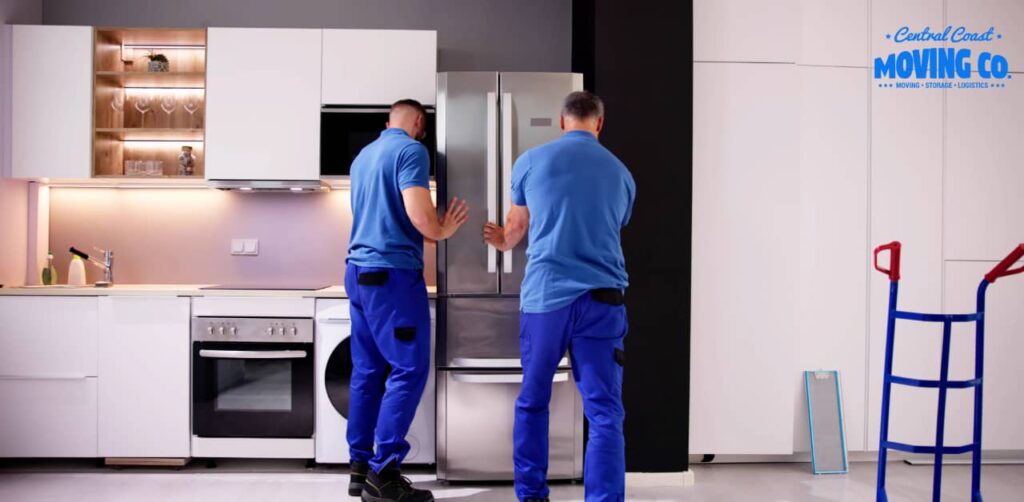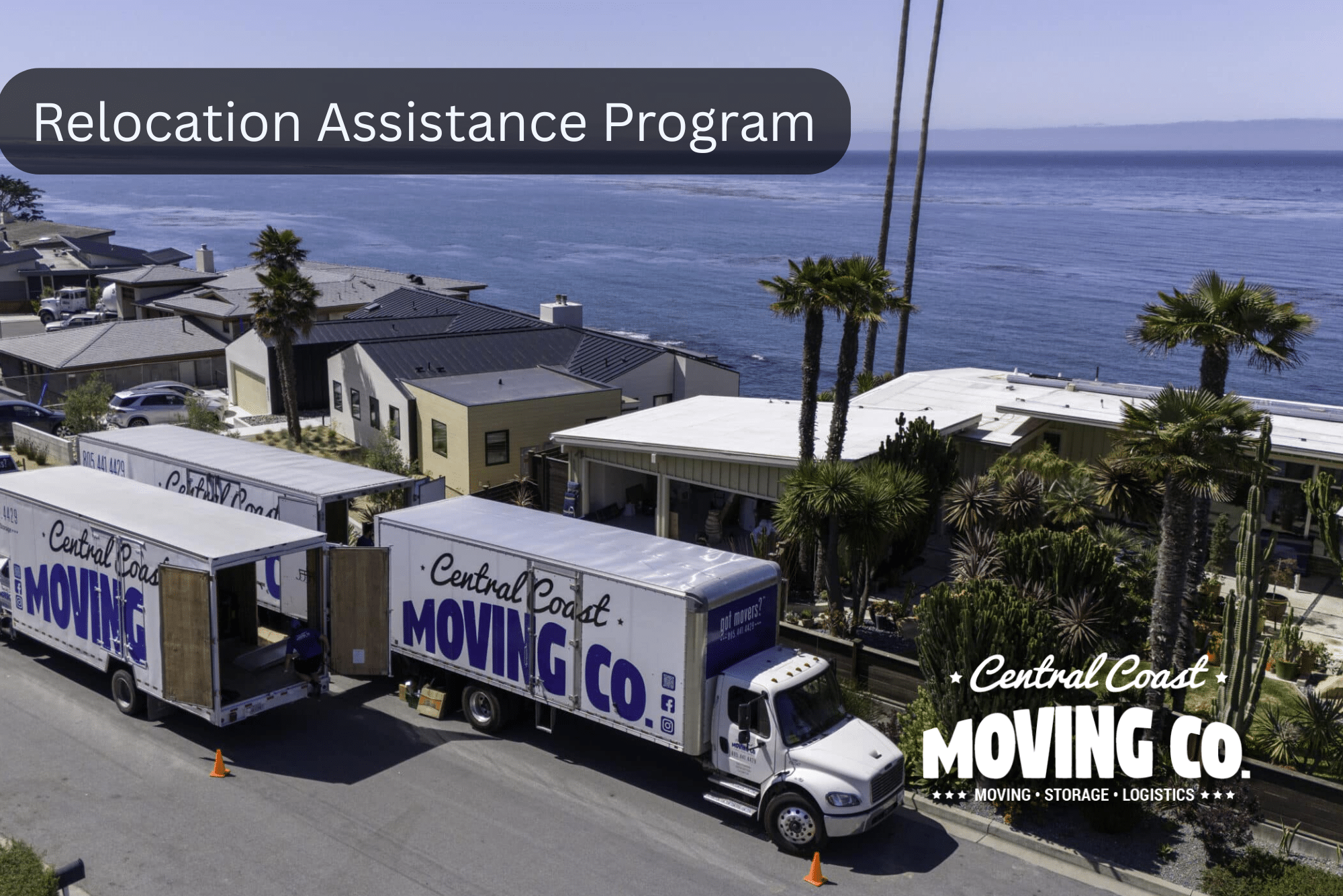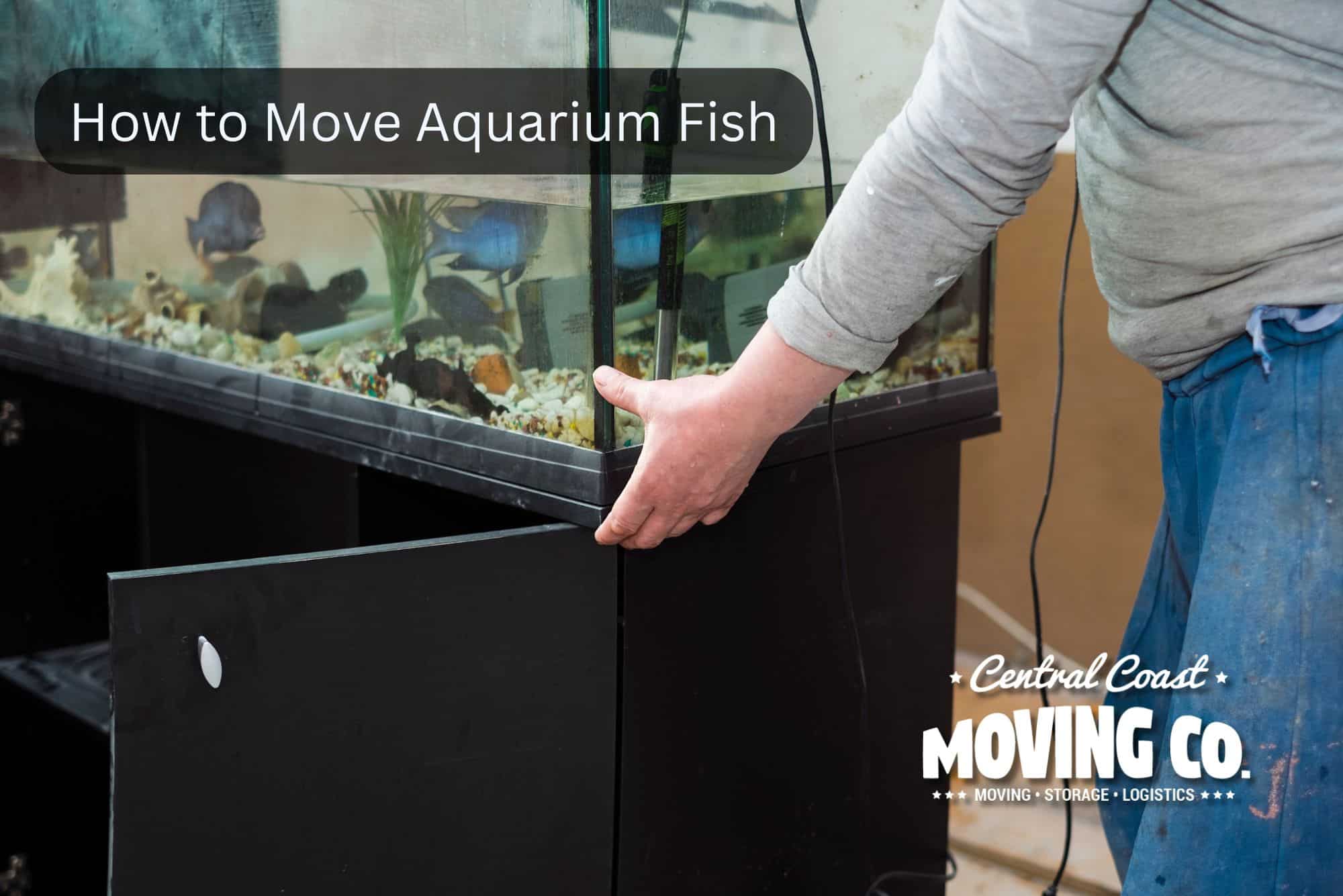Quick answer
How to move a refrigerator: Empty and unplug the unit, defrost if needed, secure shelves and doors, measure doorways and plan a route, strap the fridge to a moving dolly, roll carefully with a helper, load using a ramp, keep the appliance upright, then let it sit upright before plugging in at the new home.
Moving a refrigerator can feel intimidating. The appliance is large, heavy, and full of sensitive components that do not respond well to sudden tilts or bumps. With the right prep, tools, and sequence, you can move a fridge safely while protecting your back, your floors, and the appliance itself.
This guide delivers everything you need, from gear lists to detailed directions and local resources, all aligned with the service standards of Central Coast Moving.
Why moving a refrigerator is different
Fridges typically weigh a few hundred pounds, which makes balance and secure handling essential. When moving a refrigerator, it is crucial that the appliance remain upright at all times to prevent internal damage. T
he sealed system depends on oil and refrigerant located where the manufacturer intended, so transport position matters more than people realize. Laying a refrigerator on its side can cause coolant leaks and compressor damage, leading to expensive repairs. The right plan and the right tools prevent cracked flooring, dented doors, and costly compressor problems.
For model-specific moving instructions, always consult your owner’s manual.
Tools and supplies you will need
Gather your gear first so moving day stays efficient.
- Appliance dolly with straps. Search phrases like moving refrigerator dolly or dolly to move fridge if you are buying or renting.
- Moving straps or ratchet straps to secure the appliance to the dolly and in the truck.
- Bungee cords to help secure and stabilize the refrigerator during transport.
- Moving blankets and stretch wrap to cushion doors and finishes.
- Floor protection such as sliders, plywood runners, or floor protector sheets.
- Tape for loose cords and doors after you wrap the unit.
- Screwdriver and bag or small container for door hardware if you must remove doors.
- Coolers and ice for food during defrost and transit.
- Work gloves and closed toe shoes.
Choosing the right dolly to move a fridge
Pick a heavy duty appliance dolly with straps that cinch across the front of the refrigerator. Keep the load centered on the dolly plate, confirm the strap path does not press sharp edges into panels, and test the tilt with your helper before you roll. When handling stairs, keep the dolly at a controlled angle and move one step at a time with clear communication.
Step by step: how to move a refrigerator safely
Step 1: Empty, unplug, and defrost
Clear all food and shelves. Unplug the unit from its power source and secure the power cord so it does not drag. If you have perishable food items, store them in a cooler to keep them cold during the move.
If your freezer produces frost, plan a defrost period so the interior is dry before you move. If there is a water line for the ice maker, close the supply valve and disconnect it, then catch any drips with a towel.
Cleaning tip: Once the fridge is pulled out, clean behind and beneath it. Manufacturers warn that floor coverings can be damaged if the unit is dragged, so lay down protection and lift slightly to place sliders or a protector under the front edge before you slide.
Step 2: Remove or secure shelves and drawers
Prevent rattling glass or shifting bins. Remove glass shelves and drawers and pack them separately, or secure them with padding and tape if your model allows. Wrap the exterior with moving blankets to protect the finish. Major guides suggest removing doors only if needed for tight clearances. If you remove doors, keep hardware together in a labeled bag so reassembly is straightforward.
Step 3: Measure doorways and plan the route
Measure the refrigerator height, width, and depth. Measure every doorway, hallway, and turn from kitchen to exit. Map the path, including any steps, ramps, or thresholds. Good planning avoids last minute scrapes and saves time on moving day.
Local note: Older homes in Santa Barbara County often mix original trim with modern flooring. Add felt sliders or runners where the fridge crosses transitions so you avoid nicks on the baseboards and scuffs on newer planks.
Step 4: Strap the refrigerator to the dolly
Position the dolly centered on one side of the fridge. Tilt slightly, slide the dolly plate under the cabinet, then cinch the straps at mid height and near the top. Test the balance by easing the unit back until the weight rests on the dolly wheels. Keep doors closed with wrap or a soft strap so handles do not catch. Secure refrigerator doors with tape, straps, or bungee cords to prevent them from opening during the move.
Step 5: Roll with control, mind the stairs
Roll slowly. Spot any thresholds, uneven surfaces, or tight corners before you move.
On stairs, take one step at a time. Keep the dolly at an angle that maintains control without excessive tilt. One person guiding the dolly from the front should steer and direct the movement, while the other is pushing from behind to maintain control and safety.
Step 6: Load and secure for transport
When transporting a refrigerator, you can use either a moving truck or a pickup truck. In both cases, it is crucial to secure the appliance properly so it cannot shift during transit.
Use a truck ramp if available. Keep the refrigerator upright. Strap the unit in the vehicle so it cannot shift. Tighten straps around the cabinet and anchor to solid points.
Upright transport protects the sealed system and the compressor oil from migrating through lines. If a short side transport cannot be avoided, wait before plugging in after arrival.
Step 7: Reinstall and let the fridge settle
Move the refrigerator into place at the new home. Level it so doors close on their own and the case does not twist. Wait before plugging in. Manufacturers advise different wait times based on how the appliance traveled.
If it stayed upright, two to three hours is usually enough. If it rode on its side, leave it upright for the same time it was laid down or up to a full day for long side transport. This allows migrated oil to drain back to the compressor and reduces risk of damage.
What not to do: common mistakes to avoid
- Do not lay the refrigerator on its back. The weight of the unit can damage internal parts, and fluid shifts can create problems at startup.
- Do not skip measurements. Guessing door or hallway width often leads to dents or wall damage. Measure the unit and the path, then decide whether door removal is needed.
- Do not rush the first power up. Waiting the right amount of time after transport is a low cost safeguard for the compressor.
- Do not forget coil and wall cleaning. Dust, grit, and grease behind the fridge reduce efficiency and can cause odors. Clean behind and under the unit, and gently dust coils while the fridge is unplugged.
Local note: Coastal homes in Pismo Beach see more fine sand and salt air. Use this move as a chance to clean behind the fridge and wipe the back panel and wall so grit does not grind into floors or coil fins.
Can you move a refrigerator by yourself?
You can move a fridge solo only under ideal conditions such as a short, flat path and the correct equipment. A helper is strongly recommended. Even with an appliance dolly, stairs and tight turns require teamwork. If you are set on moving a fridge yourself, use a rated dolly with straps, protect the route, and take your time. If you encounter stairs or narrow turns, ask for help or hire a professional.
How to protect floors, walls, and doors
- Lay down protection. Place floor protector sheets or runners over hardwood, tile, or vinyl. Tilt slightly to slide the protector under the front edge before you pull the unit out.
- Pad corners and handles. Use moving blankets or corner guards so handles and doors do not mark walls.
- Control the tilt. Keep the angle modest and steady. Sudden shifts invite scuffs and can stress the sealed system.
Safety basics for lifting a refrigerator
Use your legs, keep the load close, and avoid twisting. If anything feels unstable or beyond your capacity, stop and recruit help. There is no fixed maximum lifting limit for individuals, and safety experts encourage proper material handling and the use of mechanical aids like dollies for heavy items. That guidance supports a cautious approach that favors equipment over brute force.
If you are evaluating how to lift fridge safely, the most reliable tactic is to avoid manual lifting altogether. Tilt onto an appliance dolly, secure with straps, and roll with a helper instead of trying to deadlift the appliance.
Special considerations for unique moves
Every refrigerator move is a little different, and certain situations call for extra planning to prevent damage and ensure a smooth process. If you’re moving a refrigerator with a french door or a freezer, it’s especially important to secure the refrigerator and freezer doors so they remain closed during transport.
Use plastic wrap or moving straps to keep the doors from swinging open, and add extra padding around handles and corners to protect both the appliance and your walls.
When stairs are involved, always use a dolly or hand truck and consider placing furniture sliders under the fridge to protect your floors and make maneuvering easier.
Before you begin, measure all doorways, hallways, and stairwells along your route to confirm the refrigerator will fit through without scraping walls or trim. If you encounter a tight spot, removing the fridge doors or even the doors to the room may be necessary.
Don’t forget about the interior: remove or secure all shelves, bins, and other removable parts to prevent them from shifting or breaking during the move. Packing these items separately with padding can help avoid damage.
Before moving, clean the inside of the refrigerator with a solution of baking soda and water to eliminate any lingering odors. This is especially important if the fridge will be unplugged for a while or stored before use at the new location.
By taking these extra steps like measuring, securing doors and removable parts, using furniture sliders, and cleaning the interior, you’ll help ensure your refrigerator arrives at its new location in great shape, free from unpleasant odors and accidental damage.
Hiring professional movers: when and why
While it’s possible to move a refrigerator yourself, there are many situations where hiring professional movers is the safest and most efficient choice. Professional movers are experienced in heavy lifting and have the right equipment, like dollies, hand trucks, and furniture pads, to transport refrigerators safely. They know how to navigate tight doorways and hallways, protect your floors and walls, and ensure the refrigerator remains upright throughout the move.
When you hire movers, you benefit from their expertise in securing loose items inside the fridge, disconnecting water lines, and properly taping or wrapping the power cord to prevent tripping or damage. Movers can also provide clear instructions and helpful tips for preparing your refrigerator, such as emptying and cleaning the unit, removing or securing shelves, and making sure the appliance is ready for transport.
Choosing a reputable moving company is key. Look for movers with experience handling refrigerators and other large appliances, and check reviews or ask for referrals to ensure you’re working with professionals who will treat your home and belongings with care. The advantages of hiring professional movers include reduced risk of damage to your refrigerator and home, less physical strain and stress for you, and a faster, more organized move to your new home.
If you want peace of mind and a smooth transition for your refrigerator, professional movers can handle all the necessary steps—so you can focus on settling into your new space.
What to do after the move
- Set the fridge in place and level it. Doors should swing closed gently on their own.
- Wait the appropriate time before plugging in, based on transport orientation. Upright travel usually needs a short wait. Side transport needs longer.
- Reconnect the water line if present and check for leaks.
- Clean the interior with mild soap and water, then reload food gradually once the appliance reaches the correct temperature.
- Clean behind and under the fridge as part of regular maintenance to support efficiency and reduce odors. Keeping coils clean helps temperature regulation and energy use.
Eco friendly options for old or broken units
Refrigerators contain regulated refrigerants and other components that require special handling. In California and many other regions, do not leave them at the curb without verification that a qualified recycler will recover the refrigerant. Appliance recycling recovers refrigerant and hazardous components before shredding and sorting for materials. You can also look up Responsible Appliance Disposal partners and ask your local waste authority about pick up programs.
Local note: In San Luis Obispo County, check your local waste management authority or solid waste hauler for options. Many stores and scrap partners will accept units once refrigerant is recovered. Utility bounty programs sometimes provide rebates for turning in older models.
If you would rather not deal with removal, many readers search for fridge removalists or local appliance moving services. Central Coast Moving can haul away a non working unit as part of a scheduled move, subject to local recycling requirements.
Where we work
Central Coast Moving provides refrigerator moving service in San Luis Obispo and serves Paso Robles and nearby areas. We also help homeowners and renters in Pismo Beach who need careful appliance handling in multi level or tight access homes. If your home is in or near the Railroad District, we can plan a route that protects historic trim and newer flooring.
People Also Ask: quick answers
How long should a refrigerator sit after moving?
If it traveled upright, many manufacturers say two to three hours is enough. If it traveled on its side, stand it upright for at least the amount of time it was on its side, and up to a full day for long side transport.
Can you move a refrigerator on its side?
Avoid it when possible. Upright transport is best. If side transport is unavoidable, follow your manufacturer’s instructions and wait before you plug in.
How heavy is a typical refrigerator?
Many models for homes weigh roughly two to four hundred pounds, which is why a two person team and an appliance dolly are recommended.
Do I need to clean behind the refrigerator?
Yes. Cleaning behind and underneath helps efficiency and reduces odors and dust buildup. Use a soft brush or vacuum on coils while the appliance is unplugged.
Central Coast Moving difference
We design each move around your home’s layout and your schedule. That includes the refrigerator. We bring an appliance dolly, floor protection, and the right straps for tall loads. We also plan the route from the kitchen to the truck so the move is efficient and controlled. If you are in San Luis Obispo, Paso Robles, or Pismo Beach, our crew can help with a single heavy item or a full home move. Give us a call today!







